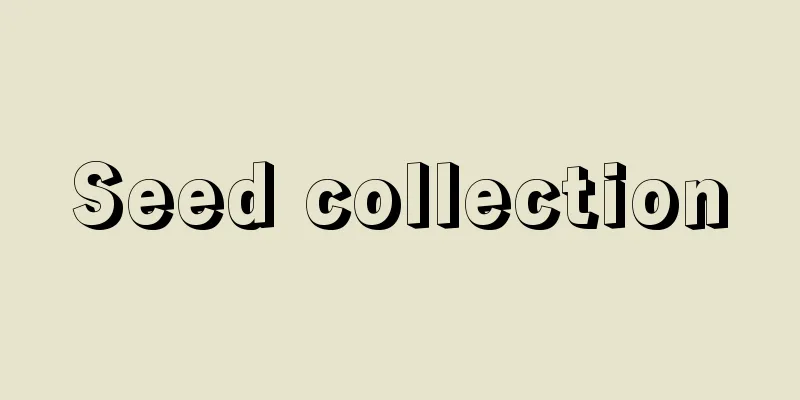Seed collection

|
It refers to the collection of seeds as a source of plant reproduction, and seed-collecting cultivation carried out for that purpose. Similarly, cultivation with the goal of harvesting seeds is not called seed collection if the seeds are to be eaten. [Hoshikawa Kiyochika] Seed collection methodIt varies depending on the type of crop, and is particularly related to the mode of reproduction of the crop. In rice and wheat, the pollen from the stamens attaches to the pistil of the same flower to produce seeds. In this way, plants that produce seeds by self-pollination are called self-fertilizing plants, and their populations are genetically uniform (homo), and they can maintain their varieties by repeated self-pollination. Such self-fertilizing plants have a three-stage system: the variety is maintained in a seed farm, seeds for seed production are multiplied in the seed farm, and seeds are harvested in a seed farm. The seed farm is the original seed used for seed production, and the field where the cultivation to obtain the seed farm is carried out. The seed farm is cultivated with the main aim of obtaining genetically uniform seeds that correctly transmit the characteristics of the variety, and the efficiency of seed harvesting is not necessarily high. The field where the seed farm is further multiplied is the seed farm. In this way, seeds are harvested in seed fields based on the original seeds that have been multiplied to a sufficient amount, ensuring the amount of seeds needed for crop cultivation. In Japan, as for self-pollinating crops such as rice, wheat, barley, and soybean, which are staple foods and have a high public value, the Major Agricultural Crop Seed Law and other related laws and regulations stipulate that the national government will take necessary measures for the production and distribution of seeds, and seed collection is carried out under the management and supervision of prefectures under the commission of the national government. On the other hand, radishes, turnips, pickled vegetables, cabbage, Chinese cabbage, spinach, etc. bear seeds when their pistils are covered with pollen from the stamens of other plants. Such plants are called outcrossing plants, and their populations are genetically polymorphic (called heterogeneous in terms of genetics and breeding), and they cannot be maintained without outcrossing (cross-pollination). Currently, outcrossing plants are mainly used for first generation hybrids (F 1 ), and F 1 seed production has become common. The first generation hybrid obtained by crossing parent varieties is F 1 , and these F 1 seeds are used as they are for actual crop cultivation. Since F 1 inherits the characteristics of both parents, it is genetically uniform, and has the following advantages: (1) it is uniform in cultivation, (2) it is possible to incorporate many genes into the same individual, which is particularly advantageous for introducing disease resistance, and (3) the effect of hybrid vigor (heterosis) can be expected. However, if the seeds of an F1 plant are cultivated and sown, the segregation of characteristics occurs according to the laws of heredity (Mendel's law), and the plant cannot be cultivated in the following years. Instead, an F1 must be created by crossbreeding the parent varieties every year and used for cultivation. Therefore, farmers must purchase F1 seeds every year, and F1 seeds have a very high commercial value. This is why the term "seed war" has been heard in recent years. Recently, it has become possible to create F1 varieties (hybrids) for self-pollinating crops such as rice and wheat by using cytoplasmic male sterility, and this is expected to become more widespread in the future. F1 seed production is carried out commercially by seed companies and the seeds obtained are highly exclusive products, so much of the technology is a trade secret and the seed production method is often not made public. [Hoshikawa Kiyochika] Precautions when collecting seedsThe most important thing to be careful of is to prevent the true characteristics of the variety from being disturbed by the mixing of different varieties, cross-pollination of different varieties, or improper seed collection methods, so strict cultivation management is carried out during seed collection. The most common seeds produced by companies in Japan are radishes, edamame, and spinach, and these three species together account for half of the total seed production by companies nationwide. Seed production requires special techniques, and good seeds need to be produced according to certain cultivation conditions, such as climate and soil, and there are traditional specialty areas for each crop where good seeds can be obtained. These are called "taneba" (seed fields). [Hoshikawa Kiyochika] [Reference] |Source: Shogakukan Encyclopedia Nipponica About Encyclopedia Nipponica Information | Legend |
|
植物の繁殖源としての種子をとること、およびその目的で行う種(たね)とり栽培をいう。同じく種子を収穫目標とする栽培でも、その種子を食用とする目的の場合は採種とはいわない。 [星川清親] 採種の方法作物の種類によって異なり、とくにその作物の繁殖の様式に深いかかわりがある。イネやコムギなどは、雄しべの花粉が同じ花の雌しべについて種子ができる。このように、自家受粉で種子が実る植物は、自殖性植物といわれ、その集団は遺伝的に均一(ホモ)であって、自殖(自家受粉)の繰り返しによって品種を維持することができる。このような自殖性植物は、原原種圃(げんげんしゅほ)で品種を維持し、原種圃で採種用の種子を殖やし、採種圃で採種するという3段階のシステムをとる。原原種とは、採種に用いる大もとの種子で、原原種を得るための栽培を行う圃場が原原種圃である。原原種は、品種の特性を正しく伝えた、遺伝的に均一の種子を得ることを主眼として栽培され、種とりの効率はかならずしも高くない。原原種をさらに増殖する圃場が原種圃である。こうして十分な量にまで増殖した原種を基にして採種圃で採種が行われ、作物栽培に必要な量の種子が確保される。 なお、わが国では、自殖性作物のうち基幹的食糧として公共性の高いイネ、コムギ、オオムギ、ダイズについては、主要農作物種子法その他の関係法令等に基づき、種子の生産、流通には国が所要の措置を講ずる旨が定められており、国の委託を受けた形態で、都道府県の管理・監督のもとで採種が行われている。 一方、ダイコン、カブ、漬菜類、キャベツ、ハクサイ、ホウレンソウなどは、その雌しべに他の株の雄しべの花粉がかかって種子が実る。このような植物は他殖性植物といわれ、その集団は遺伝的に多型(遺伝・育種上ヘテロといわれる)であって、他殖(他家受粉)によらなければ集団を維持することができない。他殖性植物では、現在では一代雑種(F1)の利用が主体となり、F1採種が行われるようになった。両親品種をかけ合わせて得られる雑種第一代がF1で、このF1の種子をそのまま実際の作物栽培用の種子として用いる。F1は両親の形質をそれぞれ受け継いでいるので、遺伝的に均一であり、(1)栽培上そろいがよい、(2)同一個体内に多数の遺伝子を組み込むことが可能であり、とくに病害抵抗性の導入に有利、(3)雑種強勢(ヘテローシス)の効果が期待できる、などの利点をもつ。しかし、F1植物を栽培して実った種子を播(ま)くと、遺伝の法則(メンデルの法則)に従って形質の分離をおこすため、次年度以降の栽培に用いることができず、毎年両親品種のかけ合わせによってF1をつくり、それを栽培に用いなければならない。したがって、農家は毎年かならずF1種子を買い求めなければならず、F1種子はきわめて高い商業的性格をもつ。近年、「種子戦争」ということばの聞かれるゆえんである。最近はイネ、ムギなど自殖性作物についても、細胞質雄性不稔(ふねん)などを用いてF1品種(ハイブリッド)をつくれるようになり、将来普及が期待されている。F1採種は種苗会社などで企業的に行われ、得られる種子は独占性の強い商品となるため、その技術は企業秘密に属する部分が多く、採種の方法は公表されていないものが多い。 [星川清親] 採種の際の注意もっとも注意しなくてはならないことは、異品種の混入、異品種の花粉の交雑や不適当な採種法などによって品種の正しい形質が乱されないようにすることであり、採種にあたっては厳重な栽培管理がなされる。わが国で企業による採種量の多いものはダイコン、エダマメ、ホウレンソウで、3種あわせて全国の企業の採種栽培全体の半分を占める。 採種には特殊な技術が要求されるほか、よい種子が得られる気候や土地など栽培条件が必要で、各作物についてよい種子が得られる伝統的な特産地ができている。これを種場(たねば)(本場)という。 [星川清親] [参照項目] |出典 小学館 日本大百科全書(ニッポニカ)日本大百科全書(ニッポニカ)について 情報 | 凡例 |
>>: Cui Zi-zhong (English name)
Recommend
Otsu pitching - Otsunagubushi
...The melody line called "Tobushi" in ...
Ichijodani
A long, narrow valley running north to south, crea...
Adamson
British photographer. Born in Scotland. In 1841 he...
Gemara
…These two Talmuds are written in Hebrew and are ...
Schreibersite (English spelling)
A phosphide with the chemical composition (Fe,Ni) ...
West Syndrome
…3Hz spike-and-wave patterns appear throughout th...
Ochu - Ouchichu
…In China and Korea, this refers to stone carved ...
Anastasios
…He was appointed Bishop of Constantinople by Emp...
Narrow-tempered
…The upper and lower limits of environmental temp...
American Literature
American literature is, of course, a part of West...
Wind and string instruments
...This may be seen as a display of each performe...
Tosa [town] - Tosa
A town in Tosa County in northern Kochi Prefecture...
Shadow Music - Kagebayashi
...The common name for kabuki music, which is use...
Espartinha - Espartinha
…a simple sandal-style footwear similar to straw ...
World War II - The Second World War
A war that took place on a global scale from Septe...





![Rudolf [II] - Rudolf](/upload/images/67cd30f89ab63.webp)



